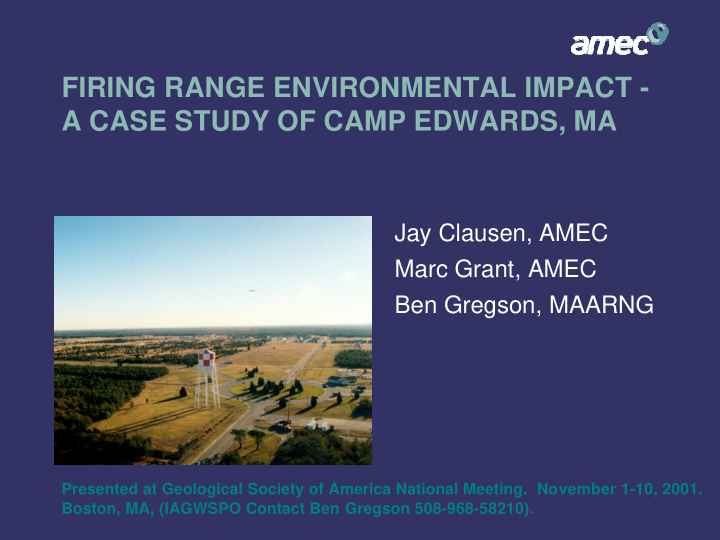



FIRING RANGE ENVIRONMENTAL IMPACT - A CASE STUDY OF CAMP EDWARDS, MA Jay Clausen, AMEC Marc Grant, AMEC Ben Gregson, MAARNG Presented at Geological Society of America National Meeting. November 1-10, 2001. Boston, MA, (IAGWSPO Contact Ben Gregson 508-968-58210).
Introduction • Military training ranges under scrutiny – Potential impacts to ecology and environment – Complex issues and problems • Major ranges receiving attention – Camp Edwards (MMR), MA - ARNG – Noman Island, MA – Vieques, Puerto Rico - U.S. Navy
Camp Edwards - Site History • Training and Impact Areas used since 1911 • Designed to house 30,000 troops during WWII • USEPA banned training in 1997 through an administrative order
Site Lithology Legend 200 VC Sand & Unsaturated ELEVATION IN FEET (MSL) Gravel 150 Zone F Sand & Silt 100 Till 50 Bedrock Aquifer Sea Level 0 Water Table Well Screen -50 -100
Hydrogeologic Model • Groundwater flow is radial with the mound to the southeast of the Impact Area in the J Range Area • Groundwater flow is approximately one foot per day
Specific Areas of Investigation
Surface Soil Findings (explosives) Other TNT 2.7% 6.3% aDNTs 32.3% RDX 37.0% 2,4-DNT 1.3% HMX 20.3%
Soil Results (explosives)
Soil Results at Artillery Target 42
Other Soil Results • Elevated metals evident (0 – 3 inches below ground surface) - Al, Fe, Mo • PAHs present • PCNs?
Groundwater Findings (explosives) RDX 65.7% HMX 21.9% aDNTs 12.4%
Plan View of RDX Detections in the Impact Area
Inner Groundwater Transect within the Impact Area 210 160 110 60 10 -40 -90
Longitudinal Cross-Section through the Impact Area 210 160 110 60 10 -40 -90
Location of Perchlorate In Groundwater at MMR
Potential Source Area • High-order detonations • Low-order detonations • UXO • EOD activities at the J Range • Disposal/Burial sites • Washout
Conclusions • RDX and HMX present in surface soil adjacent to artillery and mortar targets • RDX and HMX present in groundwater downgradient of primary target area (i.e. Tank Alley) within the Impact Area • TNT which is a component of the munitions appears to be degraded before reaching groundwater
Conclusions (cont.) • Training using HE artillery and mortar rounds (UXO, detonation, or both) appears to have resulted in an explosive impact to groundwater at MMR • Some metals, PAHs, and pesticides/herbicides present in surface soil but no evidence of impacts to groundwater • PCNs may be an issue for soil and perchlorate may be an issue for groundwater • MMR findings are potentially applicable to other bombing ranges and battlefields
Recommend
More recommend